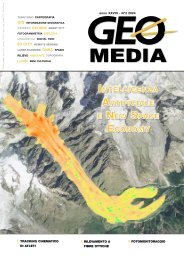You also want an ePaper? Increase the reach of your titles
YUMPU automatically turns print PDFs into web optimized ePapers that Google loves.
GUEST PAPER<br />
Fig. 4 - Example of codified enumeration area (Cemetery).<br />
Fig. 5 - Synthesis of the data integration (Bologna municipality): See the text for details.<br />
Not all enumeration parcels can be utilized<br />
for this porpoise, so it has been decided<br />
to extract just these parcels that<br />
have codes described in table 2 that<br />
have residential population less than<br />
1 resident per hectare. In figure 4 an<br />
example of an enumeration area classified<br />
according to its land cover/use.<br />
ISTAT Code N. pixels Legend<br />
5 4694 Green urban areas<br />
12 95969 Industrial or commercial units<br />
9 1775 Hospitals<br />
16 142 Sport and leisure facilities<br />
2 203 Religious institutes<br />
3 58 Monuments<br />
6 1025 Port areas<br />
7 824 Airports<br />
11 824 Military installations<br />
18 208 Research institutes<br />
24 204 Prisons<br />
50 235 Water treatment plants<br />
Tab. 2 - ISTAT enumeration aparcels code chosen to combine step.<br />
Fig. 6 - Water extraction and its land cover/use classification.<br />
How we can see, many classes are<br />
represented by a little number of pixels<br />
and these are surely eliminated if<br />
we consider the spatial resolution of<br />
a cartography product derived from<br />
LANDSAT images (scale 1:50.000); but<br />
there is to say that all of these pixels<br />
come from single enumerations areas<br />
and so they are grouped in clusters<br />
absolutely recognizable on the classified<br />
image. But it’s better to remember,<br />
that the product of this experimentation<br />
isn’t it a cartography one.<br />
So combining NDVI/NDBI image and<br />
LANDSAT classification with ISTAT<br />
enumeration parcels in raster format<br />
as describe above, we have now a<br />
new image that represent a sort of synthesis<br />
of all of these layer. In fig 5 the<br />
synthesis image (Bologna municipality).<br />
Some land cover/use indications:<br />
4Red tones: residential areas;<br />
4Purple: Infrastructures and services;<br />
4Green: Green Urban areas;<br />
4White: Sport and leisure facilities;<br />
4Dark yellow: Hospitals<br />
EXTRA-URBAN<br />
AREAS INTE-<br />
GRATION<br />
At this point of<br />
the study the<br />
problem is to<br />
relate and to<br />
define the extraurban<br />
classification.<br />
ISTAT enumeration<br />
areas,<br />
in fact, aren’t<br />
very suitable to<br />
describe land<br />
cover/use in extra-urban<br />
zones<br />
as they are for<br />
urban ones. Just<br />
few of them can be taken for this scope.<br />
For example, those that have a special<br />
area code (i.e. River, lakes, lagoons, etc.)<br />
since they are drawn exactly to the limit<br />
of these territorial features.<br />
Another problem is linked to agricultural<br />
areas; heterogeneity of these areas<br />
in terms of reflectance make the extraction<br />
of agricultural areas quite impossible,<br />
just considering LANDSAT image<br />
classification results. So another approach<br />
is needed.<br />
For this porpoise DEM and slope layer<br />
have been used. So, a sort of a ‘step by<br />
step’ extraction has been done.<br />
First of all water has been isolated<br />
using NDVI, ISTAT layer and LANDSAT<br />
classification. In fact, water can be easily<br />
extracted from LANDAST image<br />
(especially from band 2 and infrared<br />
ones); furthermore water has ever negative<br />
NDVI values too. So this land<br />
cover class has been extracted using<br />
LANDSAT image and NDVI index. But,<br />
in order to better specify ‘environmental’<br />
and use classification of the body<br />
of water, ISTAT attributes were used; in<br />
fact in ISTAT enumeration parcels attribute<br />
table there is a code that identify<br />
the most important basins and rivers<br />
by an unique national code; using this<br />
code, water land cover/use typology<br />
can be specify. An example of what is<br />
has just been said is shown on fig.6.<br />
DEM AND SLOPE<br />
The area in exam is not very nervous<br />
in morphological sense. In fact, considering<br />
Digital Elevation Mo<strong>del</strong> (DEM)<br />
realized by ISPRA (Superior Institute for<br />
environment Protection and Research)<br />
with a 20m*20m cell, it’s evident that<br />
over 50% of the DEM cell have a value<br />
less than 50 m. Moreover, considering<br />
the slope value of a DEM single cell we<br />
can see that over the 55% of the cell are<br />
completely flat.<br />
44 GEOmedia n°5-2014


















